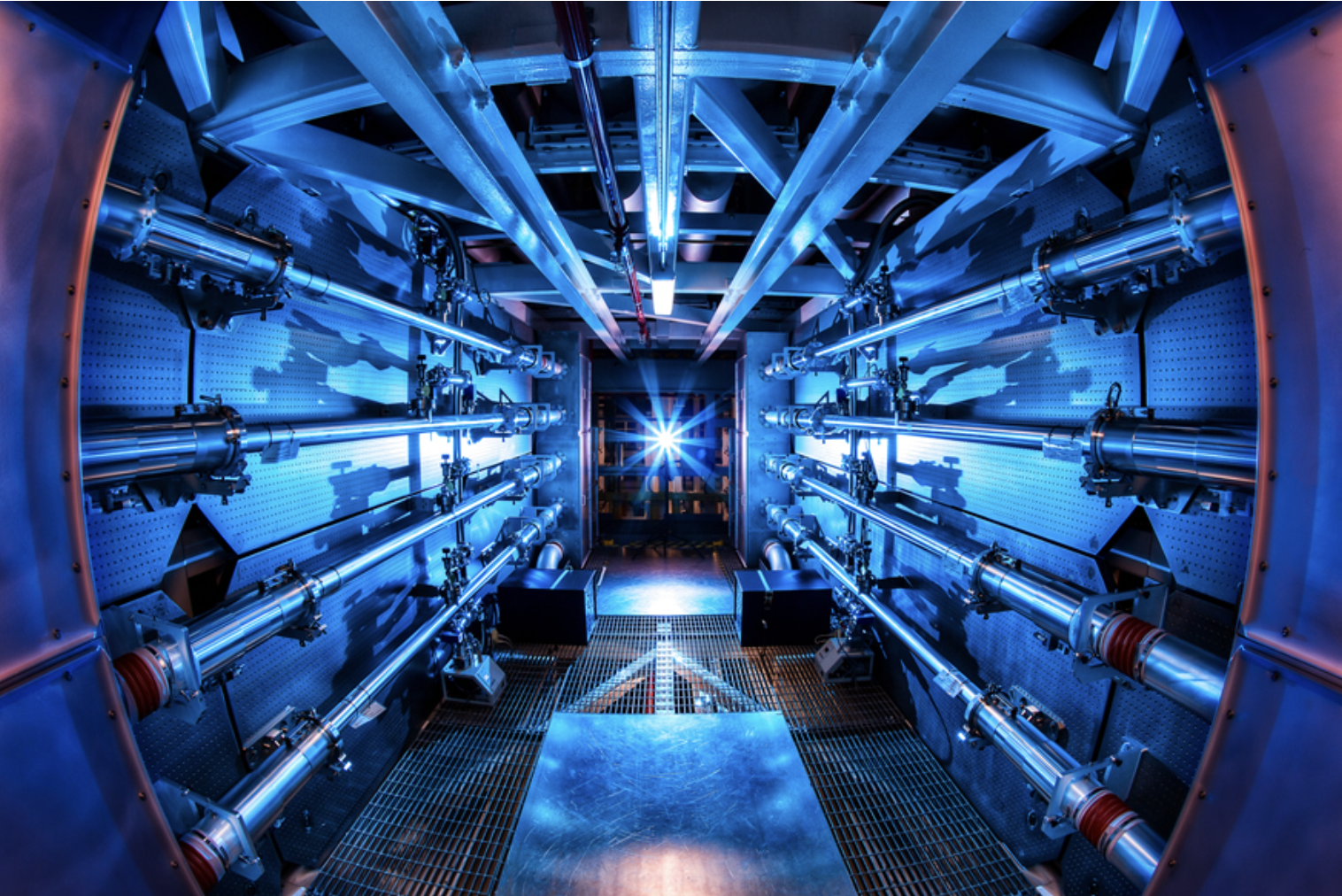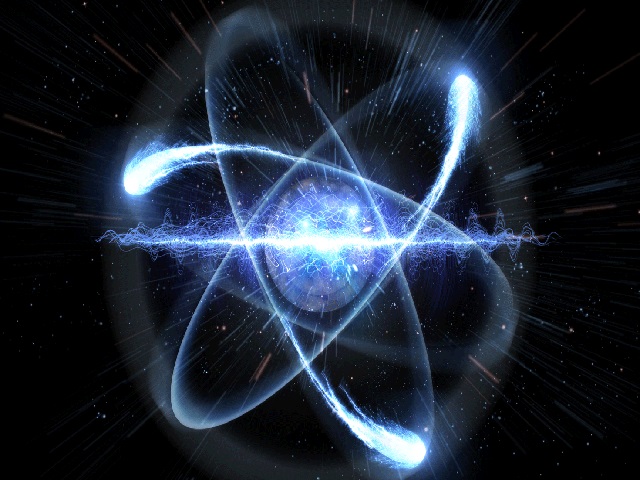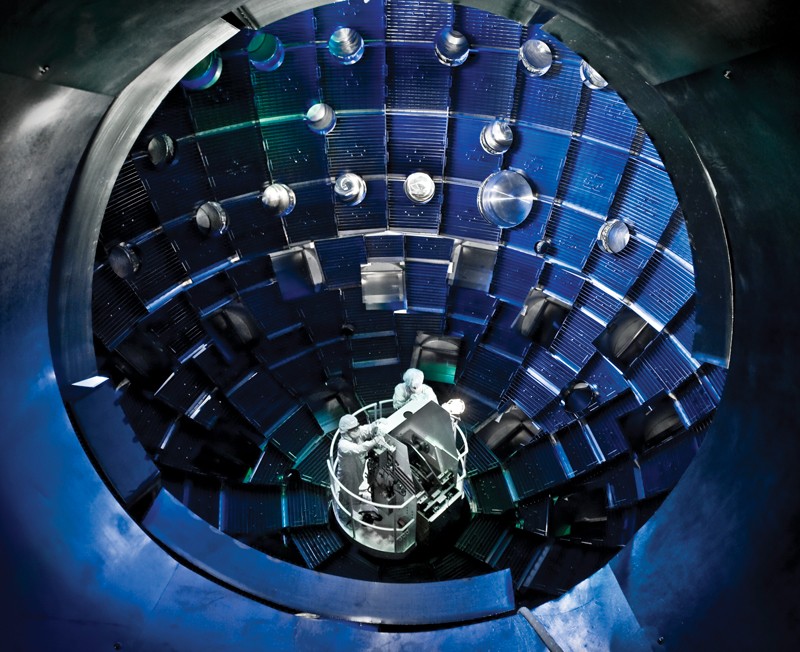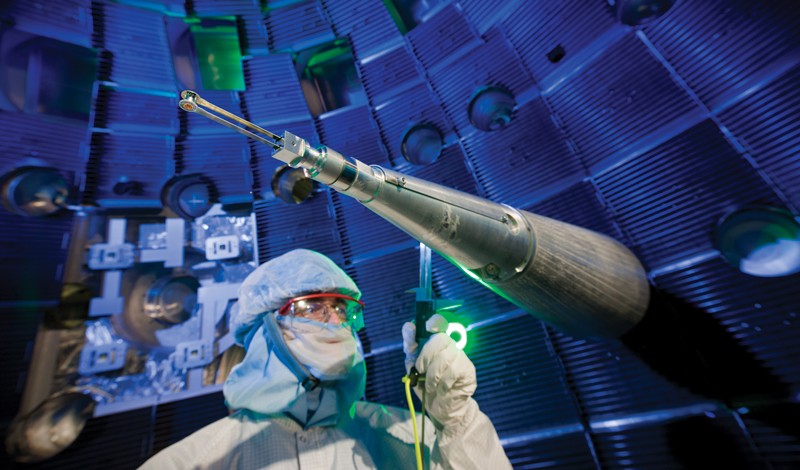Nuclear Fusion Breakthrough: What Do New Results Mean for the Future of Energy?
A colour-enhanced image of the inside of a NIF pre-amplifier support structure. Photo: Damien Jemison/NIF/US DoE
- There are two possible ways of achieving nuclear fusion: magnetic confinement and and inertial confinement.
- On August 8, the US National Ignition Facility achieved a landmark energy production of 1.3 megajoules through the inertial approach.
- While the new breakthrough is exciting, it’s worth keeping in mind that fusion will be an energy source for the second part of the century – at the earliest.
The Lawrence Livermore National Laboratory has announced a major breakthrough in nuclear fusion, using powerful lasers to produce 1.3 megajoules of energy – about 3% of the energy contained in 1 kg of crude oil.
Nuclear fusion has long been thought of as the energy of the future – an “infinite” source of power that does not rely on the need to burn carbon. But after decades of research, it has yet to deliver on its exciting promise.
How much closer does this new breakthrough bring us to the desired results? Here is a brief overview to put this new scientific advance into perspective.
What is nuclear fusion?
There are two ways of using nuclear energy: fission, which is used in current nuclear power plants, and fusion.
In fission, heavy uranium atoms are broken into smaller atoms to release energy. Nuclear fusion is the opposite process: light atoms are transformed into heavier atoms to release energy, the same process that occurs within the plasma core of the Sun.
A fusion reactor amplifies power: the reaction triggered must produce more energy than is needed to heat up the fuel plasma for energy production to occur – this is known as ignition. No one has managed this yet. The current record was achieved in 1997 by the Joint European Torus in the UK, where 16 MW of power was generated by magnetic fusion, but it took 23 MW to trigger it.
Inside the fusion chamber of the DIII-D tokamak, San Diego. Photo: Rswilcox/Flickr, CC BY-SAPIN IT
There are two possible ways of achieving nuclear fusion: magnetic confinement, which uses powerful magnets to confine the plasma for very long periods of time, and inertial confinement, which uses very powerful and brief laser pulses to compress the fuel and start the fusion reaction.
Historically, magnetic fusion has been favoured because the technology needed for inertial fusion, particularly the lasers, was not available. Inertial fusion also requires much higher gains to compensate for the energy consumed by the lasers.
Inertial confinement
The two largest inertial projects are the National Ignition Facility (NIF) at the Lawrence Livermore National Laboratory in the USA and the Laser MégaJoule in France, whose applications are mainly military and funded by defence programmes. Both facilities simulate nuclear explosions for research purposes, though the NIF also carries out research on energy.
The NIF uses 192 laser beams that produce a total of 1.9 megajoules of energy for a period lasting a few nanoseconds to trigger the fusion reaction. Fuel is placed inside a metal capsule a few millimetres across, which, when heated by lasers, emits X-rays that heat up and compress the fuel.
It was this process that, on August 8, 2021, achieved the landmark energy production of 1.3 megajoules, the highest value ever recorded by the inertial approach: that is, the closest we have come to ignition.
The overall gain of 0.7 equals the record achieved by JET in 1997 using magnetic confinement, but in this case, the fuel absorbed 0.25 megajoules of energy and generated 1.3 megajoules: fusion therefore generated a good part of the heat needed for the reaction, approaching the point of ignition.
Still, a reactor will have to achieve much higher gains (more than 100) to be economically attractive.
Magnetic confinement
The magnetic confinement approach promises better development prospects and is thus the preferred route for energy production so far.
The vast majority of research focuses on tokamaks, fusion reactors invented in the USSR in the 1960s, where the plasma is confined by a strong magnetic field.
ITER, a demonstration reactor under construction in the south of France involving 35 countries, uses the tokamak configuration. It will be the world’s largest fusion reactor, and aims to demonstrate a gain of 10 – the plasma will be heated by 50 MW of power and should generate 500 MW. The first plasma is now officially expected by the end of 2025, with a demonstration of fusion expected in the late 2030s.
The UK has recently launched the Spherical Tokamak for Electricity Production (STEP) project, which aims to develop a reactor that connects to the energy grid in the 2040s. China is also pursuing an ambitious programme to produce tritium isotopes and electricity in the 2040s. Finally, Europe plans to open another tokamak demonstrator, DEMO, in the 2050s.
Another configuration called the stellarator, like Germany’s Wendelstein-7X, is showing very good results. Though stellarator performances are lower than what a tokamak can achieve, its intrinsic stability and promising recent results make it a serious alternative.
The future of fusion
Meanwhile, private nuclear fusion projects have been booming in recent years. Most of them envision a fusion reaction in the next ten to 20 years and together have attracted US$2 billion in funding to outpace the traditional development sector.
Two different nuclear fusion deployment scenarios, compared with wind, solar and nuclear fission. Image: G. De Temmerman, D. Chuard, J.-B. Rudelle for Zenon Research, Author providedPIN IT
While these initiatives use other innovative technologies to reach fusion and could thus very well deliver operational reactors fast, deploying a fleet of reactors throughout the world is bound to take time.
If development follows this accelerated track, nuclear fusion could amount for about 1% global energy demand by 2060.
So while this new breakthrough is exciting, it’s worth keeping in mind that fusion will be an energy source for the second part of the century – at the earliest.
All about Nuclear Fusion Ignition: Process, benefits and future
Nuclear Fusion
Nuclear Fusion Reaction is recently in news because Lawrence Livemore National library in California announced an experiment that was carried out in the National Ignition Facility. It made a breakthrough in nuclear fusion research.
Know all about this research in the article written below.
Tests Performed:
The scientists at the US department of energy's flagship laser facility created a new record this time breaking the previous record set by them.
The scientists generated more than 10 quadrillion watts of fusion power for a fraction of a second. It is roughly 700 times the generating capacity of the entire US electrical grid at any time.
This revived the hope of the long troubled National Ignition Facility attaining its goal to produce more energy than its consumption in a sustained fusion reaction.
This facility is housed at the Lawrence Livermore National Laboratory and amounts to 3.5 billion US dollars. The facility was not designed to serve as a power plant prototype but to probe fusion reactions at the heart of thermonuclear weapons.
The United States had banned underground nuclear testing at the end of the Cold War in 1992. So the energy department proposed the NIF as a part of a larger science based Stockpile Stewardship Program. It was designed to test the reliability of the nuclear weapons without their detonation.
Test Results:
Result: The reactions released positively charged particles called alpha particles which in turn heated the surrounding plasma.
Plasma: At high temperatures, electrons are ripped from atom's nuclei and become a plasma or an ionised state of matter. Plasma is also known as the fourth state of matter.
Ignition amplified the energy output from nuclear fusion reactions and could help in providing clean energy for the future.
What is Nuclear Fusion?
It is defined as a combination of various small nuclei into one large nucleus. The process results in subsequent release of large amounts of energy. The process powers the sun. It harnesses fusion energy which results in an unlimited amount of renewable energy.
This type of energy is the most easily achievable energy on Earth which can be obtained by combining just two isotopes of Hydrogen: Deuterium and Tritium.
The Process and Advantages over Fission
For a nuclear fusion reaction, two nuclei must be brought closer so that the nuclear forces become active and they cause the two of the nuclei to stick together.
The nuclear forces are small distance forces which need to act against the electrostatic forces (positively charged nuclei repel one another).
Nuclear fusion's main purpose is to produce electricity. It can provide sage, clean energy for many generations to come. It is also better as considered by many against fission reactors.
The Fusion process uses less fuel than the fission process.
Fusion process avoids uncontrolled release of energy and makes less radiation than the natural background we live in.
This kind of energy reaction also does not produce high level nuclear wastes such as fission counterparts. Thus there is no need to dispose of the waste as well.
Even if generated the waste from fusion reaction would not be useful in producing weapon grade nuclear materials as is produced in fission reactors.
US achieves laser-fusion record: what it means for nuclear-weapons research
You have full access to this article via your institution.
The US National Ignition Facility (target chamber shown) is the size of three American football fields.Credit: Lawrence Livermore National Laboratory
Scientists at the US Department of Energy’s flagship laser facility shattered their own record earlier this month by generating more than 10 quadrillion watts of fusion power for a fraction of a second — roughly 700 times the generating capacity of the entire US electrical grid at any given moment. News of the breakthrough has revived hopes that the long-troubled National Ignition Facility (NIF) might yet attain its goal of producing more energy than it consumes in a sustained fusion reaction.
Housed at Lawrence Livermore National Laboratory in California, the US$3.5-billion facility wasn’t designed to serve as a power-plant prototype, however, but rather to probe fusion reactions at the heart of thermonuclear weapons. After the United States banned underground nuclear testing at the end of the cold war in 1992, the energy department proposed the NIF as part of a larger science-based Stockpile Stewardship Program, designed to verify the reliability of the country’s nuclear weapons without detonating any of them.
With this month’s laser-fusion breakthrough, scientists are cautiously optimistic that the NIF might live up to its promise, helping physicists to better understand the initiation of nuclear fusion — and thus the detonation of nuclear weapons. “That’s really the scientific question for us at the moment,” says Mark Herrmann, Livermore’s deputy director for fundamental weapons physics. “Where can we go? How much further can we go?”
Here Nature looks at the NIF’s long journey, what the advance means for the energy department’s stewardship programme and what lies ahead.
How does the NIF achieve nuclear fusion?
Ten storeys high and spanning the area of three American football fields, the NIF houses an array of optics and mirrors that amplify and split an initial pulse of photons into 192 ultraviolet laser beams, ultimately focusing them on a target that is smaller than a pencil eraser. The beams hit the target — a gold cylinder — with around 1.9 megajoules of energy in less than 4 billionths of a second, creating temperatures and pressures seen only in stars and thermonuclear bombs.
Faced with this pulse power, the cylinder, which holds a frozen pellet of deuterium and tritium, collapses as the hydrogen isotopes at the pellet’s core heat up, fuse and generate helium nuclei, neutrons and electromagnetic radiation. The goal is to unleash a cascade of particles that leads to more fusion and more particles, thus creating a sustained fusion reaction; by definition, ‘ignition’ occurs when the fusion reaction generates more energy than it consumes. Preliminary results from the experiment on 8 August indicate that fusion reactions generated a record-shattering 70% of the power that went into the experiment — nearly achieving ignition.
The NIF began operations in 2009. Why has it taken so long to (nearly) achieve ignition?
Nobody said it would be easy, but building the NIF proved to be a more complex endeavour than officials originally thought. Construction began in 1997 and ended more than a decade later, several years behind schedule and at least $2.4 billion over budget.
The NIF missed its goal of achieving ignition by 2012; scientists have spent the years since fine-tuning the facility and introducing optimized targets into the reaction chamber. The recent success was achieved after multiple changes to the massive system, including new diagnostics, improved target-fabrication techniques and enhancements to the precision of the lasers.
The NIF focuses 192 laser beams onto a target, creating temperatures and pressures like those inside thermonuclear bombs.Credit: Lawrence Livermore National Laboratory
Long before the NIF fired its first shot, it was surrounded by controversy. Independent scientists raised questions about both the design and the management of the facility. As recently as May 2016, the US National Nuclear Security Administration (NNSA), a branch of the Department of Energy (DOE) that oversees nuclear weapons and funds the NIF to the tune of around $350 million per year, questioned whether the facility would ever achieve its ignition goal.
But even long-time critics of the facility have acknowledged the recent breakthrough as a significant step forward. Stephen Bodner, a plasma physicist who formerly worked at the US Naval Research Laboratory in Washington DC, said he is both “surprised and pleased” with the result — assuming it’s reproducible. “I look forward to reading the scientific report that explains it,” he says.
The Livermore team and its collaborators are just beginning to pore over results, but preliminary data suggest an 8-fold increase in energy yield compared with experiments conducted several months ago, and a 25-fold increase compared with the previously reported record, set in 2018. Laboratory officials said they made the announcement about the experiment before peer-reviewed publication because news of the results was already spreading through the fusion community.
If the NIF achieves full ignition, what could the results teach scientists about nuclear weapons?
In theory, the NIF could offer a better understanding of the precise conditions necessary to initiate and sustain a fusion reaction — which is, in a sense, what the facility’s scientists have been working out as they’ve optimized the system over the past 12 years. This question is also at the heart of the stockpile stewardship programme.
Since 1992, physicists have been building a comprehensive programme to study the US nuclear arsenal with increasingly powerful supercomputers and dozens of other research facilities designed to test everything from nuclear materials and components to explosives. Although the NIF is not detonating miniature bombs, says Herrmann, its experiments could help scientists improve the computer models they use to simulate how weapons will detonate, potentially reducing uncertainties. Other experiments might test how the electronics and other components in a weapon hold up in the face of intense bursts of radiation expected in a hostile war environment.
Many scientists argue that the facility also bolsters confidence in the nation’s weapons stockpile — and wards off external threats — by helping to attract young researchers to the nuclear field and maintaining a broader scientific enterprise. “There is an overall element of showing scientific prowess that is important as well,” says Herrmann.
But is the NIF essential to the US stockpile stewardship programme?
Some critics have questioned whether scientists need the facility to maintain the United States’ nuclear weapons. They say the stewardship programme has already bolstered confidence in the stockpile within the NNSA, and point out that the agency is now proposing to build what are effectively new nuclear weapons, rather than simply maintaining the current cache with minimal changes.
“That shows either an enormous amount of hubris, or an incredible confidence that you can build a lot of what we need for the next 50 years, even without a functioning NIF,” says Hans Kristensen, who heads the nuclear information project at the Federation of American Scientists in Washington DC.
Herrmann argues that the NIF can still help, though. He says nuclear weapons scientists are constantly extrapolating from limited experimental data as they evaluate their computer simulations. Information gathered from more energetic fusion reactions at the NIF, he says, will allow them to test the models more directly, hopefully reducing uncertainties and making it easier for the NNSA to certify that weapons in the arsenal will detonate if needed, and not before.
So what happens next for the NIF?
The ultimate test — whether the team can replicate its 8 August success — could come as early as October, say laboratory officials. Meanwhile, scientists are rushing to understand and publish their findings. Because the facility is operating at the scientific edge of what is possible, even slight variations in the manufacture of the target capsule or the tuning of the lasers could cause the system to produce more, or less, energy than the earlier experiment, says Herrmann. “We can’t do the exact same target experiment, because we blew the target up,” he says. But with time, he adds, the science team should be able to repeat and build on this success — and push the facility even further.





